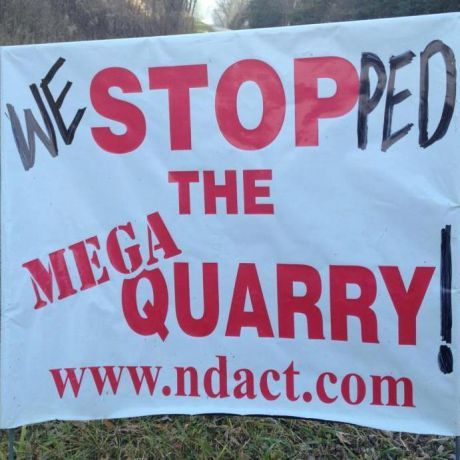News
You are here
Victory against the mega-quarry! Now shut down the tar sands

December 7, 2012
A mass campaign succeeded in stopping the proposed mega-quarry that would have devastated rural Ontario. The lessons from this victory should give confidence to the growing fight against the tar sands.
In 2006 Highland Companies, backed by multibillion dollar corporations, began buying up thousands of acres of farmland in Melancthon Township—100km north of Toronto—claiming they would continue to farm potatoes on the land. But when they began burning farmhouses, destroying bird habitat and conducting geological surveys, local residents began to investigate and to organize. As Carl Cosak said, “We're not experts or activists or anything. We're mostly farmers in our 60s, and we really don't want to have to fight for our land at this point in our lives.”
Mega-quarry, mega-activism
But local farmers discovered that Highland Companies was planning on building the largest open pit quarry in Canada. The mega-quarry would destroy 2,300 acres of farmland by creating a 200 foot crater. This would displace 600 million litres of water a day, threaten the drinking water of over a million people in Ontario, and undermine wildlife. The operations would blast, drill, and crush limestone 24 hours a day, requiring 7,000 trucks each day to remove the dusty rubble. Despite this massive attack on an environment that provides food, water, and animal habitat, the company claimed there would be “no adverse effects on its neighours or the environment.”
Last month, Highland Companies stopped its plans for the mega-quarry, stating, “While we believe that the quarry would have brought significant economic benefit to Melancthon Township and served Ontario’s well-documented need for aggregate, we acknowledge that the application does not have sufficient support from the community and government to justify proceeding with the approval process.”
The Liberal government provided no opposition, and initially didn’t even require an environmental assessment for the historic and destructive mega-quarry. But opposition was built from below, beginning as a trickle and becoming a flood. In 2009 local farmers and community members established the North Dufferin Agricultural and Community Taskforce to expose and challenge the mega-quarry.
The campaign was based on the simple demand “stop the mega-quarry” that mobilized a broad movement of local farmers, indigenous people, environmentalists and even chefs. There were letter-writing campaigns, speaking tours, lawn signs, a 5-day march from Toronto to Melancthon, and a “Foodstock” festival that mobilized 28,000 people including chefs, musicians and artisans. Forcing the Ontario government to order an environmental assessment showed the company the groundswell of opposition, and it stopped its plans. As David Suzuki said, “together, tens of thousands of people accomplished something that only months ago seemed impossible: stopping the mega-quarry.”
Next stop: tar sands
This successful campaign against the mega-quarry, and the methods it used of unity and creativity, should give confidence and inspiration to the fight against the tar sands—and we’ll need it, to shut down this much bigger planetary threat.
Multiple powerful corporations support the tar sands, which for a much longer period of time have been wrecking much greater havoc on nature and the surrounding communities—including oil spills that could devastate the west coast, and carbon emissions that threaten the entire planet’s ecosystem. The tar sands have more than just passive support from a provincial government but active support from the national government—economically in the form of funding for the tar sands and cuts to scientists, and ideologically in the form of campaigns to smear opponents and defend tar sands as “ethical oil.” The 1% are so invested in making tar sands a central component of the Canadian economy that they have the support of every major party, including the NDP leadership, on this issue.
The growing opposition is using similar strategies of unity and creativity to the ones that stopped the mega-quarry. For years indigenous groups have exposed and challenged the tar sands and the corporate lies about them having “no adverse effects” on surrounding communities or their environment. Indigenous groups have come together on the west coast to refuse the passage of tar sands pipelines, and organized speaking tours and a freedom train that crossed the country.
There are growing alliances with the environmental movement and municipalities, and the start of alliances with the labour movement. There is growing mass civil disobedience—from hundreds who were arrested on Parliament Hill last year, to thousands who joined a sit-in at the Victoria legislature this year—including members of the Canadian Auto Workers and CEP (the union representing tar sands' workers).
The involvement of the labour movement is critical. The campaign against the mega-quarry was to preserve the farming economy, and it succeeded in stopping one corporations from starting a disastrous project in rural Ontario. But the movement against the tar sands is up against a firmly established ongoing catastrophe that intends to spread through pipelines from coast to coast. All the while entrenching itself even more firmly in the fabric of the Canadian economy. Stopping the pipelines, and then shutting down the tar sands, is not just a defensive battle against pipelines, but an offensive battle against the oil-dependent economy. Success will mean imposing a massive shift to green jobs. This fight against the Canadian state will require mobilizing rank-and-file workers across the country. The fight against the tar sands is an essential part of the struggle for a better world of indigenous sovereignty and good green jobs for all.
Section:
- Log in to post comments










